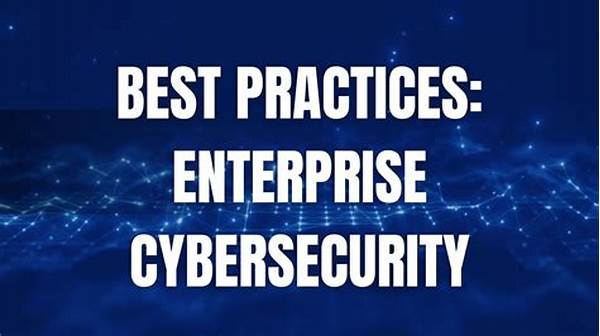In today’s digital age, the importance of robust cybersecurity measures cannot be overstated, especially for enterprises that handle vast amounts of sensitive data. Businesses are constantly at risk from emerging cyber threats that can compromise sensitive information, disrupt operations, and cause substantial financial losses. Consequently, implementing effective cybersecurity best practices for enterprises is imperative to safeguard assets and maintain customer trust. In this article, we will explore key strategies and guidelines that enterprises can adopt to ensure their cybersecurity measures are both effective and resilient.
Read Now : Inquiry-based Cooperative Math Tasks
Understanding Cybersecurity Threat Landscape
To develop effective cybersecurity best practices for enterprises, it is crucial to first comprehend the cybersecurity threat landscape. Enterprises face a multitude of threats, ranging from phishing attacks and malware to ransomware and insider threats. The sophistication of these threats has increased, with attackers employing advanced tactics such as social engineering and exploiting zero-day vulnerabilities. According to recent studies, the frequency and severity of cyberattacks are on a steady rise, urging enterprises to fortify their defenses. Establishing a comprehensive understanding of potential threats enables organizations to develop tailored cybersecurity strategies and implement controls that address specific vulnerabilities. This proactive approach not only mitigates risks but also builds a resilient cybersecurity posture that can withstand the evolving threat landscape.
Key Cybersecurity Strategies for Enterprises
1. Regular Security Audits: Conduct regular security audits to identify vulnerabilities and implement necessary improvements to protect against breaches.
2. Employee Training: Conduct comprehensive training sessions ensuring employees are aware of cybersecurity best practices for enterprises, including recognizing suspicious activities.
3. Multi-Factor Authentication: Implementing multi-factor authentication adds an extra layer of security, making unauthorized access significantly more difficult.
4. Data Encryption: Employing robust encryption protocols ensures that sensitive data remains protected both in transit and at rest within enterprise systems.
5. Incident Response Plan: Establish an incident response plan to effectively tackle security breaches and minimize damage, reinforcing your overall cybersecurity posture.
Read Now : Employment Prospects For Recent Graduates
The Role of Leadership in Cybersecurity
Leadership within an enterprise plays a pivotal role in establishing and maintaining cybersecurity best practices for enterprises. Effective leadership must prioritize cybersecurity as a fundamental aspect of business strategy, rather than relegating it to an afterthought. This involves ensuring adequate resources are allocated for cybersecurity initiatives, fostering a culture of security awareness, and maintaining open communication channels across departments. By fostering such an environment, leadership empowers their teams to be proactive in addressing potential threats and supports the integration of security protocols in all business operations. Furthermore, leading by example encourages personnel to remain vigilant and committed to adhering to cybersecurity protocols, thereby strengthening the organization’s overall defense mechanisms.
Challenges in Implementing Cybersecurity Best Practices
Despite the critical importance of cybersecurity best practices for enterprises, several challenges can impede their effective implementation. One of the most prominent challenges is the rapid evolution of cyber threats, which necessitates continuous adaptation of security measures. Additionally, budget constraints often limit the resources available for comprehensive cybersecurity solutions. Enterprises may also face difficulties in balancing security needs with user experience, as stringent measures can sometimes hinder operational efficiency. Furthermore, achieving alignment across different departments and ensuring consistent adherence to security protocols pose significant challenges. Addressing these issues requires a strategic and adaptable approach, ensuring that cybersecurity remains a dynamic and integral component of enterprise operations.
Building a Robust Cybersecurity Framework
Developing a robust cybersecurity framework is paramount for protecting enterprise assets in today’s volatile cyber environment. Such a framework should encompass not only technical solutions but also strategic policies and procedures. It must include a comprehensive risk assessment to identify vulnerabilities and prioritize resources effectively. Additionally, collaboration with external cybersecurity experts can offer invaluable insights into current threat trends and recommended practices. By instilling a culture of security throughout the enterprise, businesses can ensure that all team members, from entry-level employees to executive leadership, align with the organization’s cybersecurity objectives. This holistic approach ensures the consistent implementation and continuous improvement of the cybersecurity framework, safeguarding the enterprise’s integrity and reputation.
Summary of Cybersecurity Best Practices
In summary, the successful implementation of cybersecurity best practices for enterprises hinges upon a multifaceted approach that includes cooperation from all levels of the organization. Initial steps include conducting a thorough risk assessment to identify vulnerabilities and tailor security measures accordingly. To enhance resilience, enterprises must prioritize regular security audits and employee training programs focused on cybersecurity awareness. Finally, leadership must reinforce the prioritization of cybersecurity within the organizational culture and continuously advocate for improvements in security infrastructure. By implementing these practices, enterprises can robustly defend against current and future cyber threats, thereby ensuring the security and longevity of their operations and maintaining the trust of their stakeholders.
